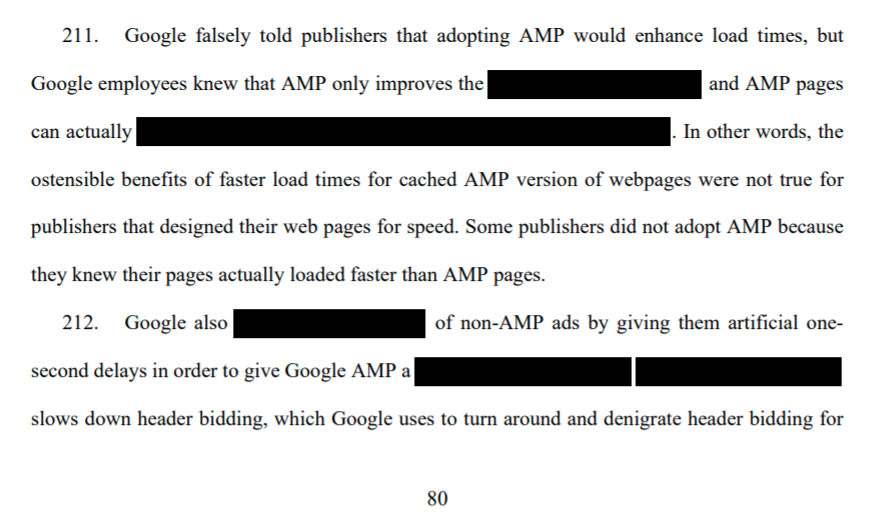Google's AMP is not made to improve speed, but ad revenue.
The US antitrust complaint against Google shows that the claim 'to improve speed with AMP' was false from the start. It is simply a measure to increase ad revenue.
Accelerated Mobile Pages, or short AMP, is software to presumably make websites faster. It was first announced by Google in 2015, and has been added to Gmail in 2019. AMP in an email service makes the emails ‘dynamic’, at least that’s what Google says.
What does AMP in emails achieve?
Basically AMP is putting apps into an email to offer dynamic content: advertisements, shops, questionnaires, and similar content that can be interacted with.
Google’s claim that AMP is necessary to make mobile pages load faster is just a marketing pitch. Or as Devin Coldewey puts it: “It’s like someone who sells bottled water telling you your tap runs too slow.”
Websites become faster if they
- don’t load ads,
- don’t autoplay videos
- don’t use lots of trackers.
All of this is what Gmail’s AMP now wants to do for the websites: load ads in Gmail, autoplay videos, and track what you click on - directly in your Gmail inbox.
Why AMP is bad
No one asked for AMP, at least not the users. This is not surprising because AMP was never designed to deliver something the users needed, it was designed to enable Google to make the web and Gmail more profitable. Google even went so far as to giving non-AMP ads artificial one-second delays compared to AMP ads.
This has now been brought to light by the US antitrust complaint against Google:


You can read the full complaint here. In 2024, Google faced another antritrust lawsuit in the US, the consequence of which could be that Google needs to break up its search and advertisement products or that Google needs to sell Chrome.
Why you should reject AMP:
- News will be presented without branding: AMP is an attempt by Google to colonize free platforms such as web and email. Google should not be infrastructure.
- What does AMP actually do with your mailbox? No ad blocker will help if your emails are delivered through Gmail.
- Marketers and Google love AMP: It’s an attempt to further increase cross-platform-tracking.
- Building fast websites is easy: AMP doesn’t magically make websites faster. Absence of trackers does.
- There’s a reason why email is still around: One of the best things about emails is that they are persistent. They don’t push advertisements into your face, they are always the same. Google is trying to fix something about emails, which isn’t even broken.
1. News will be presented without branding
Google’s AMP is bad for another reason: As content shown in Google’s AMP view is stripped of all branding even fake news will be displayed as if the content were from a legitimate news agency.
This will make the problems we already have with fake news on the web even worse, potentially destroying our democracies.
Google should not have the power to lock content into its platform and display it according to their algorithms. The example of YouTube’s clickbait algorithms already shows how harmful this can be. Google’s aim of the algorithm, after all, is not to make society better, but to make money by showing you ads on YouTube.
2. What does AMP actually do with your mailbox?
Instead of visiting websites - where you can block advertisements with an ad-blocker - Gmail now wants to display this content directly in your mailbox, marketing it as an “engaging, interactive, and actionable email experience”.
No ad blocker can stop the ads displayed in your Gmail inbox. Obviously, this is not to improve speed, but simply to track you across platforms. It is another colonialist attempt by Silicon Valley to take over the independent email platform.
Email, however, is not an app platform or an ad platform, it is a communication medium. The way it is set up - decentralized and independent, it works well with delivering messages reliably from one person to the other.
3. Marketers and Google love AMP
Marketers, on the other hand, love AMP: It allows them to display their shop directly in your inbox, making it quick and easy for you to buy something you don’t actually need at a price that most likely isn’t going to be the best offer.
Whenever marketers love something, alarm bells must start chiming. And Google is just another marketer, of course. Google’s motive with AMP is very simple: If you don’t leave your Gmail inbox for shopping, for social interaction, for booking tickets, Google controls it all.
Right now, you are leaving Gmail to do all these things on the web, and that’s infuriating Google. They want to be in charge, and they want to make money with your purchases.
Because let’s face it: Dynamic content in email has only one reason - ads. It’s Google’s business model for offering a free webmail service.
4. Building fast websites is easy
We don’t need AMP for fast websites. Building fast websites is easy if you don’t load ads, don’t autoplay videos, and don’t add lots of trackers to your site.
AMP is only necessary to make websites that WANT to add all this make them relatively fast.
5. There’s a reason why email is still around
The email protocol was designed decades ago, and as much as everyone is complaining about how outdated it is, everyone is still using it for a very simple reason: It is easy and it works.
It is a fast and easy replacement for sending letters, when using an encrypted email, it is also as secure as a sealed letter. But instead of making encrypted email easy in Gmail, Google is again pushing for advertisement options.
Google now claims that because emails are static, they are bad. But the opposite it true: Only because emails are static, they can function as a replacement of a letter - even in a legal sense. Making it dynamic would destroy this benefit of emails.
Tutanota will not support AMP
At Tutanota we believe in a free and open Internet. AMP is the opposite. Google is trying to lock content into its own system to make a profit with it.
Tutanota will not support AMP. Our business model does not rely on irritating our users with targeted advertisements, but on offering open source emails that users are happy to pay for.
Now is the best time to try Tutanota. We respect your right to privacy and don’t post ads to your mailbox. Check here why Tutanota is a great Gmail alternative and particularly why you should use Tutanota for your secure business emails.

